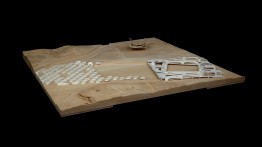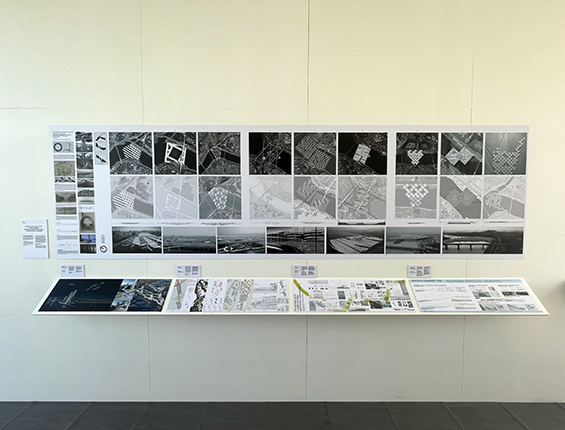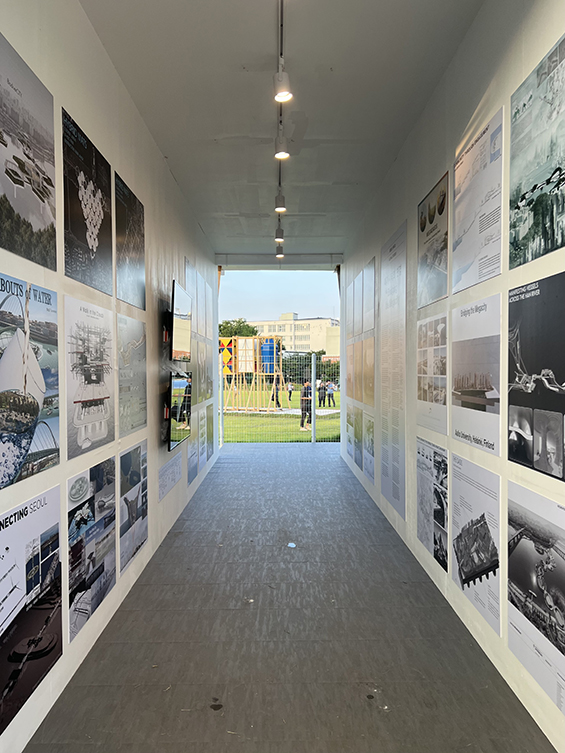Bridging the Megacity: Cooper at the Seoul Biennale
POSTED ON: September 8, 2023

One of three site models produced by Nima Javidi's Design IV studio, spring 2023. Photo by Katie Park.
The Irwin S. Chanin School of Architecture is thrilled to announce its participation in the 4th Biennale of Architecture and Urbanism in Seoul, South Korea. Work by twelve current thesis students from their spring 2023 Design IV studio section with Associate Professor Adjunct Nima Javidi is now on view from September 1 – October 31 in the Biennale’s Global Studios exhibition. The students who participated in the studio and whose work is being exhibited are Jihoo Ahn, Razaq Alabdulmughni, Jaemin Baek, Laela Baker, Aerin Chavez, Ji Yong Chung, Martina Duque Gonzalez, Alex Han, Annie He, Jiwon Heo, Rebecca John, and Xinyuan Zhang.
Hybrid Mats
At the invitation of Leif Høgfeldt Hansen, curator of the Global Studios section, Professor Nader Tehrani encouraged Javidi to organize his studio around the exhibition’s theme “Bridging the Megacity,” a prompt to consider bridge designs for three sites along the Han River bisecting Seoul. Thirty colleges and universities worldwide submitted sixty-five designs for projects sited near Noeul Park, Nodeul Island, and Seoul Forest. The Cooper Union was one of a dozen participating schools invited to exhibit its student submissions in detail.
Javidi’s studio used the Biennale’s prompt to investigate a new paradigm for bridge design. Moving away from the entangled relationship between structure and path configurations common in bridge design, this paradigm explored a fine-grain montage between patterns of ecology (waterways, windways…), structure (rhythm of columns, arches, shells…), and human settlement to create a thick, light, newly constructed, layered ground over the Han River.

Using Seoul and its unique geological condition as a starting point, the studio considered multilayered mat structures that can accommodate, through their thickness and crust, the passage and continuity of waterways, windways, and human inhabitation. This reading of infrastructure, because it operates at both human and ecological scales, informed design approaches that afford ecological continuities while allowing human settlement as an overlay. The resulting mat generated from different rhythms of structure, access, and ecological flow required reworking and montage with the edges of the bridge to create a seamless and meaningful connection with urbanity on each side of the river.
As a whole, “Bridging the Megacity” addresses the complex web of challenges that define the modern megacity of tomorrow, and its projects evoke unity and a bridge between cultures, ideas, and aspirations, transcending geographical borders to contribute to a global dialogue on sustainability and urban resilience. The bridges are not just physical connections over the Han River; they embody the multifaceted solutions that our cities demand for the future. In this era of unprecedented urbanization, cities worldwide grapple with a pressing need for collective spaces that foster interaction and community engagement. These bridges exemplify the fusion of design and purpose, offering platforms for ‘soft traffic,’ social convergence, artistic expression, and cultural exchange. They are not just functional conduits; they are vibrant arenas—addressing issues from biodiversity and water management to urban farming and air quality—that catalyze connections and invigorate the social fabric of the megacity.
Seoul Biennale
The Seoul Biennale of Architecture and Urbanism was first launched in 2017 to address urban and architecture-related challenges resulting from rapid urban growth in one of the world’s most densely populated cities. Since its inauguration, the theme of urbanism and architecture has been pivotal in reinstating Seoul as a human-centered and eco-friendly city.
The Biennale aims to harness Seoul as a testbed as it explores and seeks solutions for urban issues in global cities. It is composed of five sections: a Thematic Exhibition featuring the key theme of each edition, a Cities Exhibition inviting leading public projects from around the world, an On-site Project which engages with Seoul’s most present issues, and Global Studios and Educational Programs, which establish discussions where the people of Seoul—global and domestic experts, public institutions, and citizens alike—can participate in drawing up a common future for the city.
The 4th Seoul Biennale of Architecture and Urbanism continues ongoing discussions from its past editions—Imminent Commons, Collective City, and Resilient City—with a focus on ‘Land Urbanism’ and ‘Seoul.’





